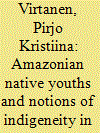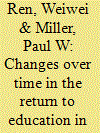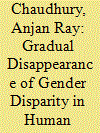| Srl | Item |
| 1 |
ID:
096477


|
|
|
|
|
| Publication |
2010.
|
| Summary/Abstract |
The indigenous presence in urban areas of Amazonia has become more visible as Indian populations have negotiated their own spaces and acted in new contexts previously reserved for the dominant society. This article looks at ways in which today's young Indians in an urban area define and interpret their new cultural and social situations, drawing from research conducted with Apurin , Cashinahua and Manchineri youths in Rio Branco, a city in Acre state, Western Brazil. These young people occupy a variety of "native" and "non-native" habituses and develop their notions of indigeneity within complex social networks as part of their strategy for rupturing the otherness associated with indigeneity. The text contributes to the discussion on the theory of practice and identity politics, as well as embodiment. Young Indians in urban Amazonia constitute their agencies in multiple ways and use various embodiments based in the practices and knowledge of their native groups and those of urban national and global society. The young natives break with the image of Lowland South American Indians as peoples uncontaminated by urban influences and help promote new interactions between native populations in the reserve and the city.
|
|
|
|
|
|
|
|
|
|
|
|
|
|
|
|
| 2 |
ID:
110256


|
|
|
|
|
| Publication |
2012.
|
| Summary/Abstract |
Studies of the return to education in urban China have reported that this has increased over time, and that females typically have a higher return than males. In this paper we adopt a framework provided by the over education/required education/under education literature, and the decomposition developed by Chiswick and Miller (2008), to investigate the reasons for these findings. The finding by Chen and Hamori (2009), from analysis of data for 2004 and 2006, of the return to schooling for males exceeding that for females, is also examined using this decomposition.
|
|
|
|
|
|
|
|
|
|
|
|
|
|
|
|
| 3 |
ID:
175111


|
|
|
|
|
| Summary/Abstract |
This study examines the existence and persistence of gender disparity in education in rural and urban India. We use the sequential logit model of regression on data sets provided by three rounds of quinquennial employment and unemployment surveys conducted by the National Sample Survey Office (NSSO). The findings of the study reveal that in both rural and urban sectors of India there is gender group disparity, and this disparity is greater in the rural sector than in the urban areas. Furthermore, it is also found that the gender groups’ disparity in education in India has substantially changed during the last two decades across both sectors.
|
|
|
|
|
|
|
|
|
|
|
|
|
|
|
|
| 4 |
ID:
118506


|
|
|
| 5 |
ID:
179715


|
|
|
|
|
| Summary/Abstract |
The generation of RES electricity in urban areas is regarded as a key element in achieving the 20% emission reduction target by 2020, in line with the strategy adopted by the European Union (EU). To understand the actual role of renewable energy planning in cities, as well as the adequacy of the strategies adopted, the authors considered statistics officially reported by the Joint Research Centre of the EU which regard the totality of submitted SEAPs and ten Sustainable Energy Action Plans (SEAPs) as sample cities. The double survey has a dual goal: one, the collection of overall statistics to have a general framework of all cities that submitted their SEAPs and to verify their inclusion of renewables, and two, the analysis of urban planning processes and climatic features through a sample of representative cities to try to determine direct connections between the implementation of renewables and real source potentials (an aspect not present in the JRC reports). Making comparisons between SEAPs submitted by European cities, the authors report in the final discussion the merits and drawbacks of the planning and usage of renewable sources in urban areas, thereby highlighting some relevant critical points and possible directions for future research efforts.
|
|
|
|
|
|
|
|
|
|
|
|
|
|
|
|